Frideswide
Fortea Morgana :) PeteByrdie certificated Princess
- Joined
- Jul 14, 2014
- Messages
- 16,873
- Location
- An Eochair
Thats a nice piece. How do they know its Roman?
and as a follow-on question, how do they know it's a hairpin?
Thats a nice piece. How do they know its Roman?
and as a follow-on question, how do they know it's a hairpin?
 maybe if all the ducks can be lined up here first, I'll drop them a line.
maybe if all the ducks can be lined up here first, I'll drop them a line.Thats a nice piece. How do they know its Roman?
My best guess would be that there are Roman hairpins that have been found and dated previously, and it is a case of comparing the find with known examples, in a similar way they do when identifying pottery fragments, tile shards etc.and as a follow-on question, how do they know it's a hairpin?
If it's a donkey then it likely represents the 1st Cromer Mounted Foot Auxiliaries.
First intact Roman-era egg recovered
Source: archaeology.co.uk
Date: 5 February, 2020
Archaeologists have recovered the first intact egg from Roman Britain among other unusual finds during investigations in Buckinghamshire.
Oxford Archaeology’s excavation at Berryfields uncovered a wealth of evidence for Iron Age and Roman occupation at the site. They found a waterlogged pit containing what are thought to be votive deposits, including four Roman chicken eggs and a well-preserved basketry tray, as well as bridge timbers that may have carried Akeman Street over the River Thame (a tributary of the Thames).
The site is located along the path of Akeman Street, an important Roman road that now lies beneath the A41, and adjacent to the site of a Roman town in the parish of Fleet Marston. It was therefore assumed that some evidence of Roman activity would be found at Berryfields – but the site yielded a much wider range of archaeology than expected.
https://www.archaeology.co.uk/articles/first-intact-roman-era-egg-recovered.htm
Experts say it is the largest of its kind found in London for more than 50 years.
The mosaic will be carefully recorded and assessed by a team of conservators before being lifted and transported safely away.
Once removed, more detailed conservation work on it can take place.
‘This is a once-in-a-lifetime find in London,’ said Antonietta Lerz, MOLA site supervisor.
‘It has been a privilege to work on such a large site where the Roman archaeology is largely undisturbed by later activity – when the first flashes of colour started to emerge through the soil everyone on site was very excited.’

Stu Neville.Yithian.swifty.enolia.james whitehead.
I was going to say skargy as well but I don’t want me head kicked in
(C) The Guardian. '22.Evidence uncovered in Preseli Hills in Pembrokeshire extends known reach further west across Britain.
The awe-inspiring beauty of the Preseli Hills and the surrounding wild moorlands have long drawn visitors to north Pembrokeshire in Wales. Now an archaeologist has found evidence that even the Romans were drawn to the area, with the discovery of an ancient road showing they travelled farther west across Britain than previously thought.
Dr Mark Merrony, a Roman specialist, tutor at Oxford University and “a native of Pembrokeshire”, said the road had been completely missed. “This thing is just extraordinary. I’m astonished,” he said.
“I think they’ll go crazy in Wales over this because it’s pushing the Roman presence much more across Pembrokeshire. There’s this perception that the Romans didn’t go very far in Wales, but actually they were all over Wales.”
He said antiquarians in the late 17th and early 19th centuries had embraced the existence of a Roman road and it had been marked on 19th-century Ordnance Survey maps. “But the idea was then rejected and removed from those maps,” he said.
Merrony spoke of finding a section of perfectly preserved Roman road buried in peat and further evidence in sunken lanes and low causeways barely discernible today but which followed straight routes and worked round hill contours “with perfect economy”, all typically Roman.
The retired farmer said: “I dug it up when I was digging a ditch in my field about six years ago. I didn’t know what it was at first but realised it was very old.
“It’s been kept in a drawer ever since. I hope a museum bids for it as I think it deserves to be on public display.
The relic, which is thought to date back to the Roman period, is set to go under the hammer at Hansons Auctioneers' Fine Art Sale in Etwall, Derbyshire this week with an estimate of £1,500 to £2,000.
"Medusa was popular in Roman antiquity and it is likely the example discovered in Somerset is Roman. Large parts of Britain, including Somerset, were occupied by the Roman Empire from AD 43 to AD 410.”
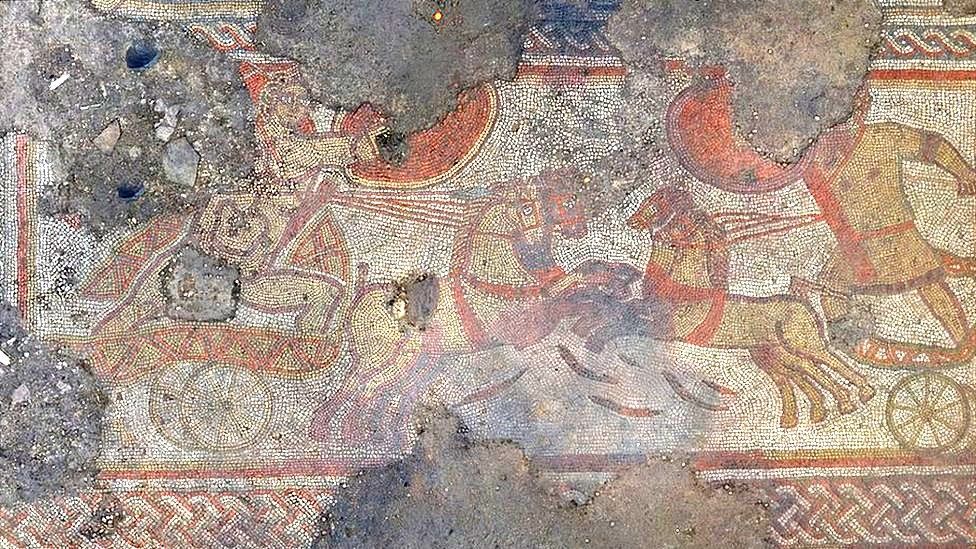
The charioteer on the left looks to have sustained a horrendous injury!More stunning finds at the Rutland farm site.
A "treasure trove" of finds has been unearthed at the site of a Roman villa discovered beneath a farmer's field.
Archaeologists said they were "gobsmacked" to find more lavish buildings and another mosaic when they returned to the area in Rutland.
Experts first found the artwork, which depicts scenes from Trojan war epic The Iliad, in a dig in 2021. Historic England hailed it as one of the most significant of its kind in Britain.
The property included a large hall, about 50m (164ft) away from the villa, featuring a bath suite with hot and cold rooms as well as extensive living spaces. It was thought to have been occupied in the late Roman period, between the 3rd and 4th Century AD. Experts believe the villa owners' extended family may have lived in the hall, which Historic England has likened to a 4th or 5th century barn conversion.
It was during the first national lockdown in 2020 when Jim Irvine first spotted some old pottery in one of his father's fields.
An archaeology enthusiast, Mr Irvine and his family started to dig and quickly realised they had found something spectacular.
IMAGE SOURCE ,HISTORIC ENGLAND Image caption, The impressive mosaic is one of only a handful across Europe
The local archaeological finds officer was informed, along with Historic England, which led to experts from the University of Leicester being brought in to carry out more detailed excavations and surveys.
They returned in the summer and uncovered more buildings - a large hall, about 50m (164 ft) away from the villa, including a bath suite with hot and cold rooms as well as extensive living spaces, likely adapted from an earlier farm building.
The second mosaic is believed to be part of a dining or entertaining area of the large villa. It features an intricate geometric pattern and further supports the theory the villa was occupied by a wealthy individual, the organisation added.
John Thomas, deputy director of the university's archaeological services, said: "The (Lliad) mosaic is a fantastic eye-catching find, but it's just one element of a much bigger settlement that we now know of from the geophysics.
"The survival is just fantastic, it's a complete one-off really." ...
https://www.bbc.com/news/uk-england-leicestershire-63326943
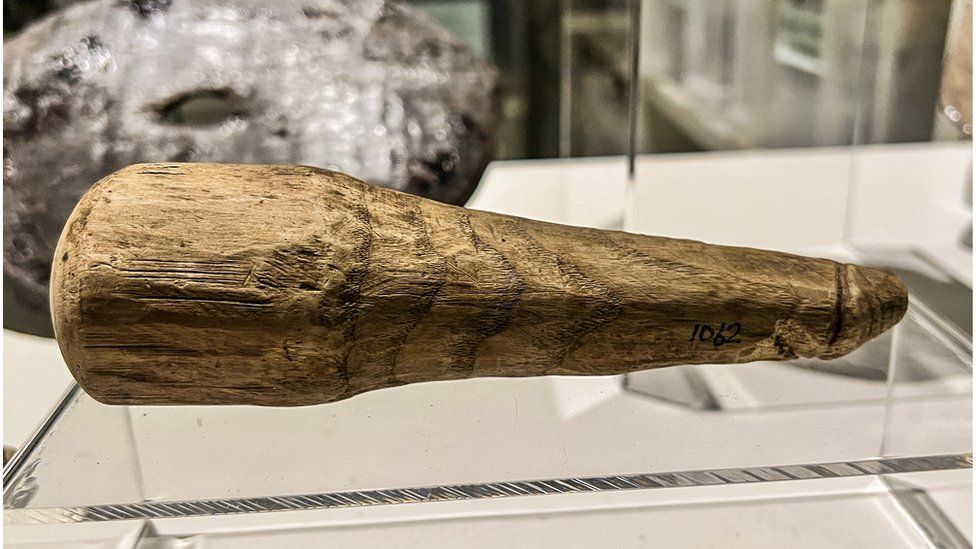
Perhaps they are confusing cobblers and cobblers?Looks as if it was put to practical use: both ends were noticeably smoother, indicating repeated use over time.
Hadrian's Wall: Wooden 'Roman sex toy' found in Northumberland
IMAGE SOURCE, THE VINDOLANDA TRUST Image caption, The wooden object was found among dozens of shoes and other accessories in a ditch
A wooden object found at a Roman fort on Hadrian's Wall initially thought to be a sewing tool may have been a 2nd Century sex toy.
Experts say the object, found in a ditch at Vindolanda, may be the earliest example of a wooden phallus found anywhere in the ex-Roman empire. However, they said they had not ruled out it could have been a good luck symbol or a tool to grind ingredients. It was first thought to be a darning tool and found with dozens of shoes.
Accessories and other small tools - along with leather off-cuts - were also found with it at the site, near Hexham in Northumberland.
'Smooth at both ends'
However, experts from Newcastle University and University College Dublin say they now believe the object, which measures about 6.2in (16cm), might have had a more intimate use.
When they analysed it they found both ends were noticeably smoother, indicating repeated use over time.
Dr Rob Collins, a senior lecturer in archaeology at Newcastle University, said: "We know that the ancient Romans and Greeks used sexual implements - this object from Vindolanda could be an example of one."
Phalli were commonplace in the Roman Empire as they were believed to offer protection against bad luck. Many are depicted in art, carved into pottery or small versions - made of bone or metal - were often worn as jewellery pendants. ...
https://www.bbc.com/news/uk-england-tyne-64678612

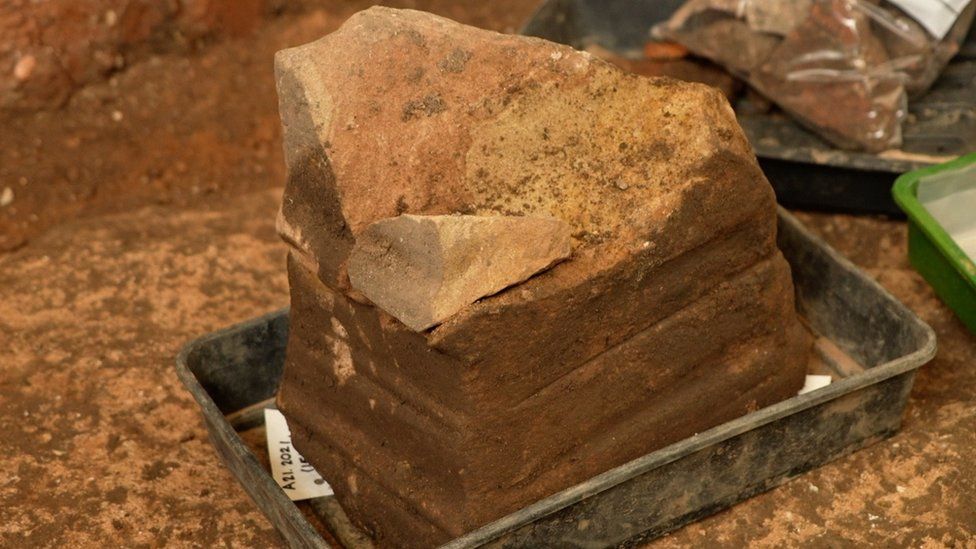
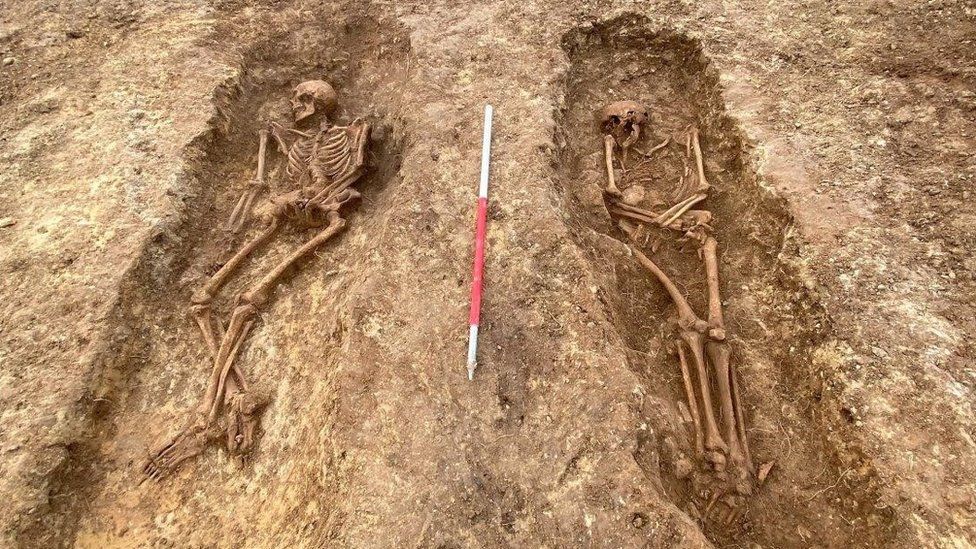
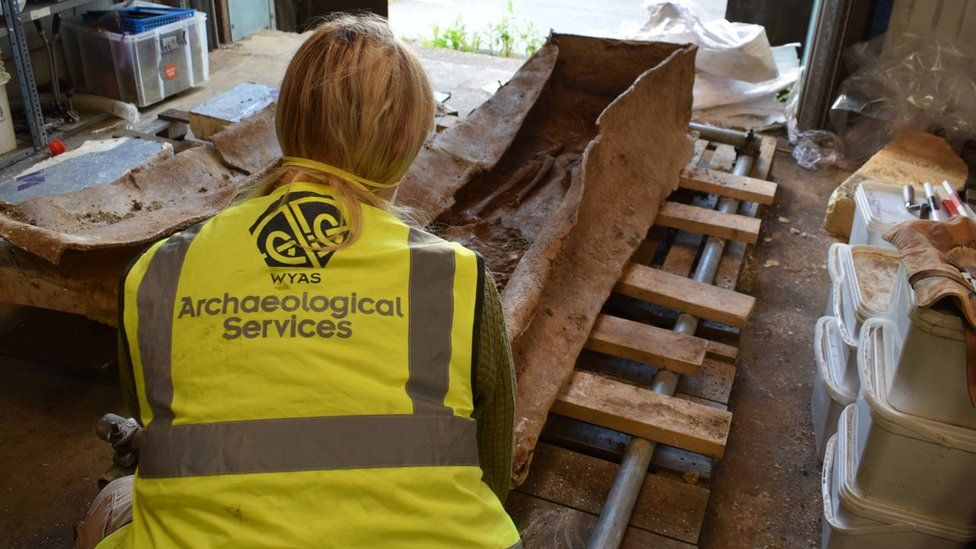
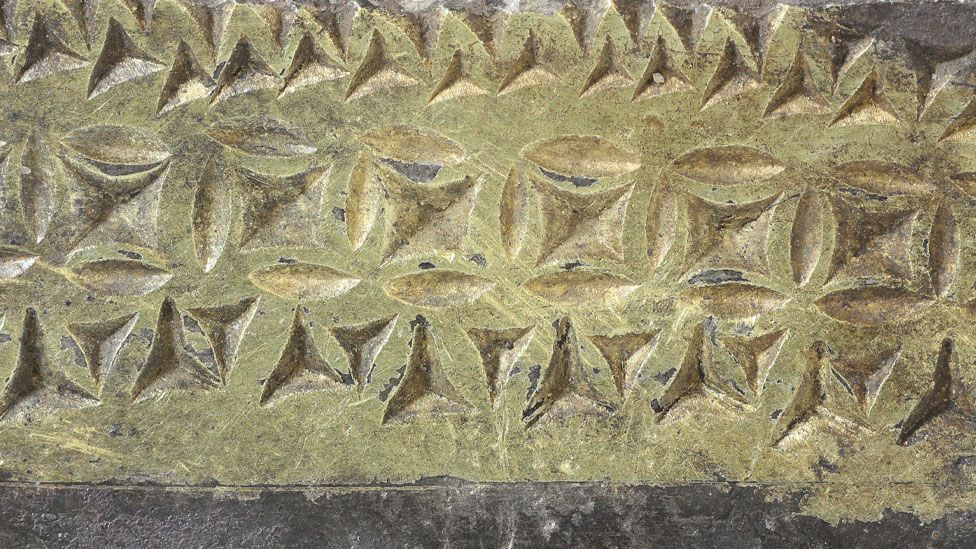
Those skeletons look in really good nick.A find which will help archaeologists to expand their knowledge of the liminal period between the fall of the Roman Empire in britain and the establishment of the first Anglo-Saxon Kingdom.
Skeletal remains of a high-status Roman woman encased in a lead coffin have been unearthed at a hidden cemetery dating back 1,600 years.
Described as a "once-in-a-lifetime find", the female remains were discovered along with 60 other bodies at the site in Garforth, Leeds.
The skeletons are believed to include both late Roman and early Saxon men, women and children.
It is thought to be the first Anglo-Saxon cemetery found in West Yorkshire.
IMAGE SOURCE, WEST YORKSHIRE JOINT SERVICES/LEEDS CITY COUNCIL Image caption, A process known as carbon-14 dating will help determine a precise age of the remains
IMAGE SOURCE, WEST YORKSHIRE JOINT SERVICES/LEEDS CITY COUNCIL Image caption, Several archaeologists worked for weeks excavating the site and removing the lead coffin
The cemetery was discovered as part of a standard archaeological survey on the site, which had been earmarked for development.
Experts said the fact the coffin had been made out of lead signified the skeleton was someone of importance.
David Hunter, principal archaeologist for West Yorkshire Archaeology Advisory Service, said: "Lead coffins were expensive. The fact the family gave this person the expense of getting sheets of lead and the expertise to make the coffin, then it tells us a lot."
Other burial practices found in the cemetery indicate early Christian beliefs as well as Saxon burials, which were accompanied by personal possessions such as knives and pottery.
Mr Hunter said: "At Garforth we've got the Roman graves which are roughly east west in alignment and the Saxon graves which are north south in alignment, so the differences stand out like a sore thumb."
Archaeologists who worked on the excavation hope the site can help chart the largely undocumented and historically-important transition between the fall of the Roman Empire in about 400AD and the establishment of the Anglo-Saxon kingdoms that followed. ...
https://www.bbc.com/news/uk-england-leeds-64917979
